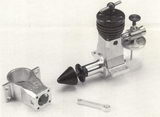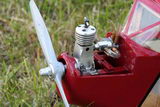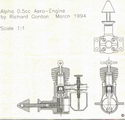Engine Design for Beginners:
The Gordon Alpha 0.5cc Diesel
Last update: Feb, 2007
Click on photographs to view in more detail
Richard Gordon has had two compression ignition (aka diesel) designs appear in the Model Engineer—although "in" may be the wrong term as both his engines were published as removable supplements to the venerable magazine. His first was the diminutive 0.1cc "Nano" from Issue #3832, November 1992. The second appeared four years later in Issue 4027 of October 1996. This 0.5cc design he named the "Alpha".
 Calling the Alpha a "beginners' project" may be a bit misleading. Certainly by the criteria we've been applying in this series so far, it fails badly, or does not even qualify. It is small, requiring close attention to fits at tiny sizes. Added to that, construction involves thread-cutting for the screw-in backplate, and the manufacture of three special-purpose cutters. The reason I've included it is because the article leads beginner designers through the decisions and compromises Richard Gordon faced in a most instructive and enlightening way.
Calling the Alpha a "beginners' project" may be a bit misleading. Certainly by the criteria we've been applying in this series so far, it fails badly, or does not even qualify. It is small, requiring close attention to fits at tiny sizes. Added to that, construction involves thread-cutting for the screw-in backplate, and the manufacture of three special-purpose cutters. The reason I've included it is because the article leads beginner designers through the decisions and compromises Richard Gordon faced in a most instructive and enlightening way.
 His design uses a fabricated, two piece crankcase. The "main" section is cut from 16mm thick plate (5/8" would be close enough for Imperial builders). While milling to shape would be quicker, there's no reason it could not be done just as well with files. In either case, the lower section would be best formed using the lathe saddle as a shaper. This process was described in the Weaver construction series and trust me, it's a lot easier than it looks. The front bearing is a simple turning, attached to the main section with Locktite 638 anaerobic adhesive. If I had a criticism about the design, it would be the potential weak spot this creates in a highly stressed area. A more reliable connection would be achieved by screw-cutting, preferably left handed, backed up with a thread-locking grade of Locktite. I tried this construction idea on a ML Midge crankcase and had it fail in moments of the first start—although the Alpha, being smaller in capacity than the Midge, would not stress the small gluing area so highly. And see the screw in the case of this example by an English builder? Rather supports my argument, I think.
His design uses a fabricated, two piece crankcase. The "main" section is cut from 16mm thick plate (5/8" would be close enough for Imperial builders). While milling to shape would be quicker, there's no reason it could not be done just as well with files. In either case, the lower section would be best formed using the lathe saddle as a shaper. This process was described in the Weaver construction series and trust me, it's a lot easier than it looks. The front bearing is a simple turning, attached to the main section with Locktite 638 anaerobic adhesive. If I had a criticism about the design, it would be the potential weak spot this creates in a highly stressed area. A more reliable connection would be achieved by screw-cutting, preferably left handed, backed up with a thread-locking grade of Locktite. I tried this construction idea on a ML Midge crankcase and had it fail in moments of the first start—although the Alpha, being smaller in capacity than the Midge, would not stress the small gluing area so highly. And see the screw in the case of this example by an English builder? Rather supports my argument, I think.
The remainder of the engine is quite standard for a little side-port. The special cutters that are required are fully detailed in the article. As usual they are made from drill rod, then hardened and tempered. They are used to port the cylinder liner, mill a transfer passage in the front wall of the crankcase, and cut conrod clearance slots in the inner sides of the crankcase cavity. No commercial cutter would do the job.
 The greatest value to beginners in this article is way that Richard Gordon guides the reader through the design process, step by logical step. At the time he designed this engine and the Nano, he was an engineering student and so is not afraid of diluting his audience with a little math. He starts out from a basic set of requirements for bore and stroke, then examines choices facing the designer to select the type of porting best suited to the rev range required. Next he considers bearing stresses and pressures to size the conrod and validate his material type selection.
The greatest value to beginners in this article is way that Richard Gordon guides the reader through the design process, step by logical step. At the time he designed this engine and the Nano, he was an engineering student and so is not afraid of diluting his audience with a little math. He starts out from a basic set of requirements for bore and stroke, then examines choices facing the designer to select the type of porting best suited to the rev range required. Next he considers bearing stresses and pressures to size the conrod and validate his material type selection.
With these decisions made, he lays out the crankshaft, cylinder, piston and rod to achieve a compact design and decides on the timing figures. Those chosen were: exhaust 130°, transfer 110°, and inlet 77°. The latter is purposely set lower than the more usual figures (which he states as 80 to 90°, though I'd go a bit higher). This, he explains, is to improve starting qualities by raising crankcase pressure at the time the transfer opens. A side effect is a decrease in fuel consumption, although this come at the expense of some peak performance. His text goes through the simple trigonometry calculations that provide these figures from the stroke and conrod length.
The design considerations consume about one half of the 16 page article. The remainder provides machining procedures for the engine and special purpose cutters. The engine could be built by a moderately experienced model engineer, or someone who has made a diesel or two before (the Midge, for example). In closing, he mentions having built 31 Alphas and that all were easy to start. These, and 21 Nanos (plus an unknown number of twin cylinder Nanos) helped finance his engineering degree. Reprints of the Alpha article should be available through the Model Engineer Plan service.
![]()
Back to the Model Engine News Home Page
Please submit all questions and comments to [email protected]
